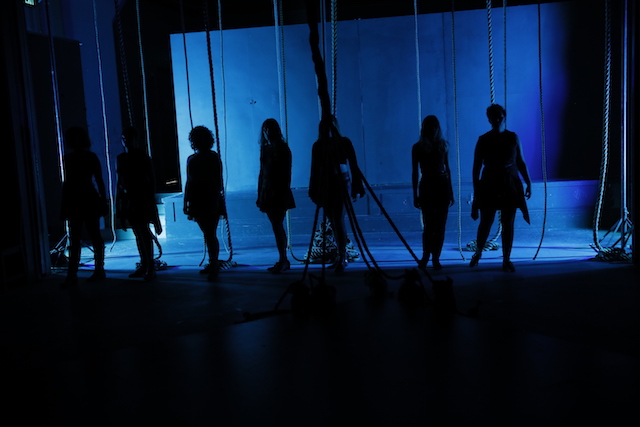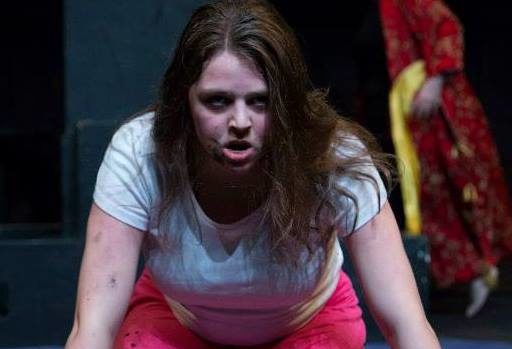Yes, And: Imagining New Narratives
I have a “Yes, and” relationship with theater. “Yes, and” is a term used in improvisation to advance a story that has been initiated – to give it life beyond what has already been established. This is what I believe needs to happen in the world of theater. I love the theater. It is where my heart truly lies, AND I recognize the need to expand our stories and imaginations beyond the expected and accepted.
I recently started listening to The Last Five Years on Spotify, a 2001 musical by Jason Robert Brown, that is not-so-loosely based on his failed marriage to actress Theresa O’Neill. The show explores the 5-year relationship of Cathy Hyatt and Jamie Wellerstein as they navigate the ups and downs of their careers and commitment to each other. The music is beautiful, energizing, and moving and the story structure is very clever. You can read more about the plot here, if you are interested. The characters are well-developed and complex, and you get drawn into the oscillating tension of their relationship that is doomed from the beginning of the show. While the two characters are given relatively equal stage time in their alternating songs, Jamie’s story seems to be subconsciously centralized by the male playwright and composer. His plot-line is focused on his ambitions and career, while Cathy’s focuses more on their relationship. To be fair, Brown does explore the trials and tribulations of being an actress and a woman in this society, and his stand-in, Jamie, offers his emotional and financial support for Cathy to pursue her career. However, this centralizing of the male perspective is extremely prevalent in all kinds of media, and it is one of the invisible pillars of the patriarchy that keep women down and restricted to traditional gender roles and tiny boxes of acceptable behavior. A few examples. Spoilers ahead.
Jamie’s songs are much more active and dynamic.
I’ve watched videos of the original performance and Norbert Leo Butz, who played Jamie, was given almost free reign to leap around and take up space; to be loud and messy and complicated. On the other hand, Cathy, played by Sherie René Scott, sat or stood still for many of her songs, and they were styled more as ballads or lounge songs – sexy and emotional, as women are expected to be.
This is something that I have recently been taking more notice of as it relates to theater as a whole. So often, women seem to be onstage as decoration – a pretty face in a man’s world. They are made up to the nth degree and put in clothes and shoes that restrict their movement, making them less dynamic to watch than men who are wearing flat shoes and pants that allow them free range of motion. As an actor, I am finding it more and more appealing to wear what’s comfortable to auditions, rather than fit into what is expected.
This also applies to voice. In my sophomore year at Cornish College of the Arts, we were taught about the “non-gendered voice,” a modification of Megan Kennedy and Sid Jordan Peterson’s educational training on the pillars of heteronormativity, in preparation for “gender swapped” scenes from Ibsen’s A Doll’s House. We had done the scenes the “traditional” way in our freshman year, and now we were being encouraged to explore another perspective. However, our preparation for the non-gendered voice did not include raising or lowering the natural pitch of our voices to “fit” the gender we were portraying; it was about recognizing that every voice is right for any expression of self. The transformation comes from fully inhabiting the character and empathizing with them. This practice is encouraged in MCC Theater’s Miscast Gala in New York City, in which Broadway stars are given the opportunity to sing songs they would not otherwise have the opportunity to. It seems like a very empowering and life-affirming experience, and certainly in recent years, it has become more all-inclusive. However, there has also been a decent amount of privileging (especially white) men in being able to experience roles written for women. One such example is Norbert Leo Butz singing “It’s All Over” and “And I’m Telling You I’m Not Going” from Dreamgirls. It is honestly brilliant and gives one the impression that this part was made for him (though for obvious reasons it wasn’t). Once again, as he is wont to do, he was fully embodied and impassioned – utterly transformational. Even wearing a simple suit, he became Effie White. On the flip side, the women playing the men in the songs wore tall heels and floor-length dresses, and became restricted to a spot on the stage. We seem so often to be restricted to a spot. This is not meant to be a judgement on their performances; rather, it is a challenge to theater makers – writers, directors, producers – to do better by female performers.
I recently saw Dance Nation at Washington Ensemble Theatre (WET) in Seattle, WA, which examined competitive dance among (mostly female) teens, played by adult actors of all ages. It was probably the most honest, raw, and cathartic piece of theater I have seen. The reason: it showed womxn in all their complexity. We are not just nice and pretty, nor are we only petty and bitchy. Reducing us to these stereotypes prevents our stories from moving forward. And the only way we can change the established standard is by living our own values and encouraging others to do the same. For me, that means putting more womxn center stage, rather than having every real or imaginary universe revolve around a man’s story. Hypocritically, I find myself being drawn into men’s storylines more because they are usually more complex. It’s hard to imagine yourself as the hero if you never see that represented. There are plenty of examples from history for men to draw inspiration from – for womxn, not so much. Which brings me to my next point.
Jamie is incredibly self-centered.
While he does offer Cathy support during her career struggles, so much of his narrative is about his own career and what he needs. He seems to never be satisfied with what he has, and while this is a very human quality and can lead to growth and advancement, if it carries over into personal relationships it can be very harmful. In Jamie’s case, it leads to lying to Cathy and not showing up for her as a partner. He is so focused on his own trajectory that he neglects to see the ways he’s hurting Cathy, choosing instead to deny his part in their eventual separation and blame it on her “neediness.” This echoes the cry that women are “overly emotional and unstable,” when in fact we are just very relationship-oriented. We care about the people in our lives and about the whole system. We think about the mechanics of it and take notice when something is not right. This is called intuition and it is a useful and powerful tool. Men could afford to use it more often, rather than relying solely on logic and “fact”. Tying it back to Jamie, if he had openly expressed his fears of intimacy with Cathy, it seems likely that a constructive conversation could’ve taken place, rather than the heartbreak that ensued.
I have experienced this dynamic within my own family, with unspoken fears and grudges building up until they reach a boiling point and it is too late to stop them from overflowing and creating a gigantic mess. It is harder to pick up the pieces when they are scattered on the floor, or when pieces get conveniently lost and not included in the reassembled picture.
This kind of projection is something that we all struggle with, and it takes a lot of work to overcome. It is easier to blame someone else for how your life has turned out than to own the ways in which you have contributed to your own suffering. In Nobody Needs to Know, Jamie says, “All that I ask for is one little corner/ One private room at the back of my heart/ Tell her I found one/ She sends out battalions/ To claim it and blow it apart.” We all deserve our time and space, but that does not come from selfishly taking it without regard for the other people in your life. It comes from communicating what you need and hoping that the people who love and care about you will accommodate that.
My mom, brother, and I live in a studio apartment together, and especially during this quarantine that can get pretty stifling. Sometimes we get on each others’ nerves and there’s nowhere to go, but most of the time we flow with the group, checking in and giving each other space as needed. I am probably the worst at asking for what I need in the moment, mainly because of social conditioning (and probably partly due to my Scorpio Moon). While my family tends to advocate for self-expression, there are plenty of other sources that dim this light for me. As a woman, I feel selfish if I want time to myself just to focus on my own interests or creative projects.
We just watched the television show Dickinson on Apple TV, starring Hailee Steinfeld, which is a fact-based imagining of Emily Dickinson’s life, but with modern dialogue and scored with pop music such as Billy Eilish. In it, Emily is constantly having to battle her parents for an ounce of freedom to focus on her writing. The sense of entitlement is strong when she coerces her dad into hiring a maid so she doesn’t have to help with the housework, or feigns terminal illness so she can finish a poem. However, there is a very poignant (though imagined) scene in which she travels to meet Henry David Thoreau and finds him in a secluded cabin, being waited on by his mother and sister who do his laundry and bring him cookies. This takes entitlement up to eleven, and Thoreau’s smugness is excellently portrayed by comedian John Mulaney. The toxicity of this situation is palpable, and it is something that is not far removed from our times. In fact, in many places in the world, and within our own country, it still exists.
My mom recently introduced me to another fear response, besides “fight, flight or freeze”: fawning. This is when someone who is weak and/or vulnerable, which has historically been women and children, care-takes someone who is bigger, stronger, or who has more power, in order to please them and reduce the retaliation against any perceived threat to that power. An excellent example is Margaery Tyrell, played by Natalie Dormer, in the Game of Thrones series. She strokes King Joffrey’s ego in order to win his affection and ultimately become the queen of Westeros. Joffrey is a selfish, spoiled, sadistic, and psychotic man-boy, who is incredibly volatile and vindictive. Not someone you would want to challenge in any way, especially if you’re a woman. So the way Margaery navigates his unpredictable nature, while still getting her way, is to fawn over him.
Nora Helmer does the same thing in A Doll’s House, with her husband Torvald, playing the role of his “little songbird” and “squirrel,” in order to keep her place in their well-ordered “doll’s house.” When we did our “gender swapped” scenes (mentioned above), I drew a parallel between Torvald Helmer and George Banks from Mary Poppins. There is an abrupt shift in Winnifred Banks from Sister Suffragette when she is marching for her rights with her fellow women, and The Life I Lead, when she is taking notes for George and hanging on his every word – being the “good little woman.”
Cathy also assumes this role in The Last Five Years, allowing herself to be taken for granted because of Jamie’s charm. In A Part of That, she says “I tend to follow in his stride/ Instead of side by side/ I take his cue… And when I do/ Then he smiles.” This mindset is incredibly codependent and really shows that…
Jamie’s love is conditional.
There is a whole, lovely song, The Schmuel Song, in which Jamie expresses his confidence in Cathy and encourages her to quit her day job and pursue her dreams, giving her the gift of “unlimited time.” But this support is almost revoked when she calls him out on his self-centeredness and the attention he rakes in from other women at parties. Her boundary-setting is so repelling that he slinks off to have an affair with another woman. What’s worse is that we expect this kind of behavior from men. We accept the idea that “they can’t help themselves.” Bullshit. Feeling attraction toward people outside of your primary partner is completely normal, but pursuing those feelings is a whole other conversation. If you are feeling tied down, maybe it is a healthy choice to let go and move on, but only if you are doing so consciously and with an awareness of the other party’s feelings. You don’t have to hide. And if you feel you do, maybe it’s for the best not to be with that person. Openness and honesty are where it’s at. Everyone should feel safe to express their thoughts and feelings with their loved ones, as long as you are doing no harm and acknowledging your part in the overall system. Traditionally, women have done more than their fair share of this work – the concept known as “emotional labor” – and it is time for men to start showing up and actually engaging in the hard conversations rather than seeking out “the next best thing” (i.e. what’s younger and hotter).
Hollywood is rife with this kind of behavior, and older women constantly get put up on a shelf once they reach a certain age. I recently watched a 1999 Larry King Live interview with Mary Tyler Moore and Dick Van Dyke, where they talked about their careers and what it was like getting work at their ages (63 and 74, respectively). Dick said he’s never stopped working, while Mary expressed the difficulty that women have getting roles when they are older. Mind you, he is 11 years older than her. Women are taken for granted in all realms of society, and are frequently relegated to mother roles once they turn even 40 years old. A shocking example of this is when Angelina Jolie played Colin Farrell‘s mother in the 2004 film Alexander, when she was 28 and he was 27.
My mom said yesterday that they would like to see a hero’s journey story that starts in mid-life, as opposed to the innumerable ones we see of young 20-somethings going out and trying to make their way. This is much more common among men, less so among women. You only have to look at the cast of the Marvel Cinematic Universe to see just how prevalent the Hollywood age and gender gap is. And it’s not just Hollywood. As Cathy sings in Climbing Uphill, “I’m up every morning at six/ And standing in line with 200 girls/ Who are younger and thinner than me/ Who have already been to the gym.” The expectations of female perfection are so high, and youth is so prized that people like the beautiful, vibrant Mary Tyler Moore feel the need to get plastic surgery and end up looking like a stiff shell of their old selves. I don’t judge it; I just think it is incredibly sad.
We need to start honoring our female elders, rather than casting them aside to grab what’s new. We need to look deeper into the things that actually matter about a woman, rather than the size of her breasts or her “fuckability.” As Jo March says in Greta Gerwig’s Little Women, “Women, they have minds and they have souls, as well as just hearts. And they’ve got ambition and they’ve got talent, as well as just beauty. And I’m so sick of people saying that love is just all a woman is fit for, I’m so sick of it.”
The final line of Nobody Needs to Know is, “Since I have to be in love with someone/ Since I need to be in love with someone/ Maybe I could be in love with someone like you.” During this song in the film version of The Last Five Years, Jamie is shown sleeping with a seemingly endless line of interchangeable women who cycle through and then disappear, making this line all the more poignant. Jamie doesn’t really know what he wants, and that’s fine. What’s not okay is taking advantage of however many women you feel you need to in order to feel whole. We are not here for you.
There is a lot to be mined from this show, and a lot more going on than what I’ve explored above. But I feel it necessary to call out these tropes because they exist in so many other places in the greater world of creation. In my senior year of high school I researched sexism in the film industry and made a short documentary about it. That was 2014. The Last Five Years was written in 2001. 13 years apart, and yet the same themes are there: objectification, idealization, taking women for granted. This is not real news. Take it back even further to, say, The Dick Van Dyke Show and the circumstances are even worse. These themes have a long-standing history. So what do we do about it?
I am actually not an advocate for completely eliminating exposure to these worn-out narratives. I believe they are all part of our history and, if regarded with a critical lens, can inform how we face the future – and the present. What I advocate for is creating new stories – new realities, even – for our imaginations to dwell and to find something surprising. Stand-out examples include Fleabag and Schitt’s Creek, created by Phoebe Waller-Bridge and Dan Levy respectively, which both feature messy, complicated characters trying to figure out their lives and find their place in the world. Certainly, there are some tropes because those are our shared context at this point in human history, but these shows add some new perspectives to the mix. Fleabag shows a young woman coping with tragedy, guilt, an increasingly unsettling family life, and the ambiguity of sex and love in the modern era. Schitt’s Creek explores what happens when a privileged family loses everything and has to come to terms with themselves and find meaning in a completely new community and environment.
Both of these shows are about belonging. I think a lot of art is. Art gives us tools to make sense of our world. It gives us a window into another reality. But we have to make sure that reality is reflecting the full scope of humanity and not just the privileged few. The stories of white men should not disappear. They still deserve to have their voices heard; their voices just need to be decentralized and balanced out with the voices of the rest of the world population. I believe the best way to bring about this balance is to keep creating.
I’ve historically had a hard time finding my own voice in the vast amount of stories and media that are available to be experienced, but I have recently discovered a passion of mine that can provide a good basis for storytelling: historical fiction. In just the past couple of decades, we have begun to realize just how skewed our history books are and how little minority experiences are represented. I feel very grateful to have been exposed to Howard Zinn’s A People’s History of the United States in high school, unlike my mom who heard nothing but patriotic propaganda when they attended high school in the ’80s. Now that we understand these inequities, it is time to reclaim our stories. History is written by the victors, but no one can know who the ultimate victor will be. That is determined by those who have been oppressed continuing to stand up and demand our place in the history books. Hopefully, we can all be the victors and the heroes of our own stories. That is the world I want to help create.






